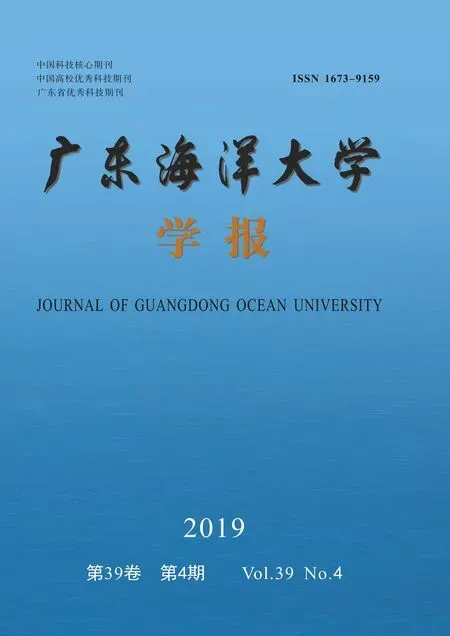中国短毛藻属Elachista的分类学II
——包括1个新种
2020-01-16丁兰平刘金梅姜晶晶栾日孝黄冰心
丁兰平,刘金梅,姜晶晶,栾日孝,黄冰心
(1.天津师范大学生命科学学院,天津市动植物抗性重点实验室,天津 300387;2.中国科学院海洋研究所, 山东 青岛 266071;3.大连自然博物馆,辽宁 大连 116023)
中国短毛藻属Elachista的分类学II
——包括1个新种
丁兰平1,2,刘金梅1,姜晶晶1,栾日孝3,黄冰心1,2
(1.天津师范大学生命科学学院,天津市动植物抗性重点实验室,天津 300387;2.中国科学院海洋研究所, 山东 青岛 266071;3.大连自然博物馆,辽宁 大连 116023)
【目的】研究采自我国沿海岸的褐藻门短毛藻科Elachistaceae短毛藻属Elachista的分类。【方法】对采自我国沿海岸的短毛藻进行形态学鉴定,描述新种的形态特征以及其他分类学信息,并与相似种进行比较。【结果】鉴定出长海短毛藻E.changhaiensisLuan et Ding、短毛藻E.fucidola(Velley) Areschoug、暗色短毛藻E.fuscaLuan et Ding和细枝短毛藻E.tenuissimaLuan et Ding sp.nov.等4个种,含新种1个。细枝短毛藻藻体暗褐色,半球形,直径4~5 mm;基部由薄壁细胞组成基垫;同化丝可分成长同化丝和短同化丝,长同化丝较短,长1~2 mm,由63~128个细胞组成,直径6.0~9.5 μm;短同化丝较长70~225 μm,直径3.5~6.0 μm。单室囊囊状,多室囊线状。模式标本存在中国科学院海洋研究所海洋生物标本馆(AST)。
短毛藻属;分类;新种;褐藻;中国海
短毛藻属Elachista隶属于褐藻门Phaeopyta索藻目Chordariales短毛藻科Elachistaceae,由Duby建立[1]。其主要特征为藻体(孢子体)丛生或扩展;基部由无色假膜组织组成,呈垫状或半球状,附着或部分深入其他海藻的组织中;同化丝着生于假膜组织上,在基部分枝,可分为长同化丝和短侧丝(短同化丝),侧丝多弯曲丛生;基部生长,色素体盘状,多数;单室囊和多室囊生于同化丝之间;异型世代交替,配子体为微小匍匐体。模式种为E.scutellataDuby [=E.scutullata(Smith) Areschoug]。本属在国际上已报道66个分类单位,目前可接受物种24个,其中,东亚11个(可接受的)[2-7],我国报道短毛藻E.fucicola(Velley) Areschoug[4,8-9]和纤细短毛藻E.tenuisYamada[10]等2个种。笔者自1999—2003年对中国沿海多个地区开展野外调查,收集了部分短毛藻属标本。结合文献报道和标本,经鉴定,发现我国短毛藻属4种,包括1个新种,详细描述新种形态特征,以丰富我国大型海洋褐藻的多样性。
1 材料与方法
1.1 材料
1999—2003年间作者在我国沿海野外现场调查采集的标本及之前保存在中国科学院海洋研究所海洋生物标本馆(AST)的部分标本。
1.2 方法
1.2.1 显微观察及绘图 实验材料经切片后在显微镜下观察并绘图。外形特征主要包括藻体颜色、基部情况、同化丝的类型、繁殖器官等特征。
1.2.2 物种鉴定 通过分类特征的对比及相关数据的比较,结合文献鉴定物种。
2 结果
2.1 长海短毛藻
Elachista changhaiensisLuan et Ding 2018,p.107-111[11]。
特征描述:藻体黄褐色,半球形,直径 3~4 mm,附着于其他海藻上。基部为假膜体,在假膜体外缘生有游离的长同化丝和侧丝(短同化丝)。色素体小球形。无毛。多室囊由 23~38 个小室组成。
习性和产地:在低潮线下附着于Sargassum confusum的叶面上,与Protectocarpus speciosus混生。产于辽宁长海县海洋岛。
地理分布:中国黄海。
模式标本产地:辽宁省长海县。
2.2 短毛藻(图1)
Elachista fucicola(Velley) Areschoug 1842,p.235,pl.8,figs.6-7[11];Setchell et Gardner 1925,p.503,pl.38,figs.33-35[12];Taylor 1957,p.140,pl.10,figs.1-3[13];Abbott et Hollenbeng 1976,p.178,fig.145[14];Tseng et al.1984,p.174,p1.88,fig.3[4];Luan 1989,p.81,fig.99[8];Tseng et al.2008,p.328,fig.224[9].
Conferva fucicolaVelley 1795,fig.4[15].

图1 短毛藻 Fig.1 Elachista fucicola (Velley) Areschoug
特征描述:藻体黄褐色,球形或半球形,直径5~12 mm。半球状垫部由无色丝体密集胶着在一起组成假膜组织,外部由营养丝体组成,仅在下部分枝,上部为单列丝体,单列丝体分长短两种。长丝为大而游离的同化丝,即长同化丝,直径40 μm,向基部渐细,顶端钝圆。短同化丝在长同化丝下部,棒状,略弯曲,上部细胞呈念珠状。无毛。
单室囊椭圆形或倒洋梨形,多室囊线形、单列,生于同化丝基部。
习性和产地:在低潮带或石沼中多附着在其他大型海藻体上。可成为其他海藻的敌害藻。产于辽宁大连、长海,山东。
国外分布:北大西洋,美国太平洋。
模式标本产地:英格兰(England)。
2.3 暗色短毛藻
Elachista fuscaLuan et Ding 2018,p.107-111[11]。
特征描述:藻体暗褐色,半球形。基部由薄壁细胞组成垫状假膜体。着生于假膜组织细胞上的同化丝可分成长同化丝和侧丝(短同化丝)。无毛。单室囊和多室囊同体。
习性和产地:在中潮带附着于Sargassumconfu- sum藻体上,与Halothrixgracilis等混生。产于大连。
地理分布:中国渤海。
模式标本产地:中国大连。
2.4 细枝短毛藻(新种)(图2)
Elachista tenuissimaLuan et Ding sp.nov.
藻体暗褐色,半球形,直径4~5 mm,附着于其他海藻上。基部由薄壁细胞组成基垫,下部少数细胞伸入宿主表层组织间。垫部细胞不规则圆柱状,长20~75 μm,宽10~25 μm,长为宽的2~5。同化丝着生于垫状体上,可分成长同化丝和短倍同化丝(侧丝)。长同化丝长1~2 mm,由63~128个细胞组成;上部细胞长15~32 μm,宽6.0~9.5 μm,长为宽的1.6~5.3倍;中部细胞长10~25 μm,宽6~8.5 μm,长为宽的1.2~3.7倍;下部细胞长1.2~30 μm,宽6~8 μm,长为宽的1.6~5倍。短同化丝长70~225 μm,由5~15个细胞组成;上部细胞长15~25 μm,宽4.5~6 μm,长为宽的3.3~4.2倍;下部细胞长15~20 μm,宽3.5~5 μm,长为宽的3 .0~5.7倍。
单室囊囊状,无柄,着生于同化丝的基部,长75~140 μm,宽20~40 μm。多室囊线状,不分枝或少数分枝。
习性和产地:在潮下带附着于Sargassumsp.体上。产于福建漳浦古雷镇。
地理分布:东中国海。
模式标本:于2000年5月18日由栾日孝采自福建漳浦,模式标本号为AST20009180。

图2 细枝短毛藻(新种) Fig.2 Elachista tenuissima Luan et Ding sp.nov.
新种与其相似物种间的比较见表1。

表1 新种与其相似物种间的比较 Table1 Comparison between the new species and their related species

续表1(Continued)
2.5 中国短毛藻属 Elachista分种检索表
已报我国道短毛藻属有4个种,即长海短毛藻、短毛藻、暗色短毛藻和纤细短毛藻(E.tenuisYamada)[10]。但纤细短毛藻除野田光藏报道[10]外,未再在国内发现其分布,故不能确定。本研究报道了该属1新种,因此,我国短毛藻属确认的种为4种,检索表如下。

1.藻体直径在5 mm以上…………………………………………………………短毛藻 E.fucicola 1.藻体直径在5 mm以下…………………………………………………………2 2.长同化丝略粗,下部直径在15 μm以上 ………………………………长海短毛藻 E.changhaiensis 2.长同化丝细,下部直径在15 μm以下 …………………………………3 3.长同化丝直径8~14 μm,短同化丝直径7.0~7.5 μm………………………暗色短毛藻 E.fusca 3.长同化丝直径6~9 μm,短同化丝直径3.5~6 μm…………………………细枝短毛藻E.tenuissima
[1] DUBY J É.Aug.Pyrami de Candolle Botanicon gallicum sen synopsis plantarum in flora gallica descriptarum[M].Editio secunda.Ex herbariis et schedis Candollianis propriisque digestum a J É Duby V D M.Pars secunda Plantas Cellulares Continens.Paris: Ve Desray,Rue Hautefueille,1830: 545-1068.
[2] GUIRY M D,GUIRY G M.Algae Base[M/OL].World-wide electronic publication.Galway: National University of Ireland.[2018-11-08].http://www.algaebase.org.
[3] PERESTENKO L P,VODOROSLI Zaliva Petra Velikogo.The seaweeds of Peter the Great Bay[M].Leningrad: Akademia NAUKA SSSR.Dal,1980: 1-231.
[4] TSENG C K.Common seaweeds of China[M].Beijing: Science Press,1984: 1-318.
[5] YOSHIDA T.Marine algae of Japan [M].Tokyo: Uchida Rokakuho Publishing Co.,Ltd.,1998: 1-1222.
[6] KLOCHKOVA N G,KOROLYOVA T N,KUSIDI A E.Atlas of algae-macrophytes Kamchatka waters.Vol 1.Green algae and brown algae[M].Petropavlovsk-Kamcha- tsky: KamchatNIRO Press,2009: 1-216.
[7] KIM H S,BOO S M.Algal flora of Korea.Volume 2,Number 1.Heterokontophyta: Phaeophyceae: Ectocarpales.Marine brown algae I[M].Incheon: National Institute of Biological Resources,2010: 3-137.
[8] 栾日孝.大连沿海藻类实习指导[M].大连: 大连海运学院出版社,1989: 1-129.
[9] 曾呈奎,夏邦美,丁兰平,等.黄渤海海藻[M].北京: 科学出版社,2008: 1-453.
[10] 野田光藏.中国东北区(满洲)の植物誌[M].东京: 風間書房,1971: 1-1612.
[11] 黄冰心,姜晶晶,刘金梅,等.中国短毛藻属Elachista(褐藻门)的分类学研究I.两个新种[J].海洋科学,2018,42(9): 107-111.
[12] ARESCHOUG J E.Algarum (phycearum) minus rite cognitarum pugillus primus [J].Linnaea,1842,16: 225-236.
[13] SETCHELL W A,Gardner N L.The marine algae of the Pacific coast of North America.Part III.Melanophyceae[M].Botany: University of California Publications in Botany,1925,8: 383-898.
[14] TAYLOR W R.Marine algae of the northeastern coast of North America [M].Ann Arbor: The University of Michigan Press,1957: 1-509.
[15] ABBOTT I A,HOLLENBERG G J.Marine algae of California [M].Stanford,California: Stanford University Press,1976: 1-827.
[16] VELLEY T.Coloured figures of marine plants,found on the southern coast of England;illustrated with descriptions and observations: accompanied with a figure of the arabis stricta from St.Vincent's rock,to which is prefixed an inquiry into the mode of propagation peculiar to sea plants [M].Bath: Hazard,1795: 1-18.
Morphological Taxonomy on GenusElachista(Choradariales,Phaeophyta) from China Seas II,with Description of One New Species
DING Lan-ping1,2,LIU Jin-mei1,JIANG Jing-jing1,LUAN Ri-xiao3,HUANG Bing-xin1,2
(1.Collage of Life Sciences,Tianjin Normal University,Tianjin Key Laboratory of Animal and Plant Resistance,Tianjin300387,China;2.Institute of Oceanology,Chinese Academy of Sciences,Qingdao266071,China;3.Dalian Museum of Natural History,Dalian116023,China)
【Objective】To study the taxonomy of genusElachista(Phaeophyta,Elachistaceae) from the Chinese coasts.【Method】The specimens of genusElachistawere investigated from the Chinese coasts,and identified by morphological classification methods.The new species morphological characters were described,and compared with similar species.【Result】Four species were identified,including one new species,viz.E.changhaiensisLuan et Ding,E.fucidola(Velley) Areschoug,E.fuscaLuan et Ding andE.tenuissimaLuan et Ding sp.nov..Thalli of the new species are dark brown,hemispheric,with 0.4 —0.5 cm in diameter,and epiphytic on other macroalgae.The bases consisted of parenchymal cells to a cushion-like structure,with a few cells of the lower portion stretching into the host co rtical tissue.The cells of the cushion-like part are irregularly cylindrical,20—75 μm long (L),10—25 μm broad (B),andL/B2—5.The assimilating filaments were born on the cushion-like structure,consisted of long assimilating filament and short assimilating filament (paraphysis).The long assimilating filaments are 1—2 mm long and consisted of 63—128 cells with 1.2—30μm,10—25 μm and 15—32 μm long,6—8 μm,6.0—8.5 μm and 6.0—9.5 μm broad,andL/B1.6—5.0,1.2—3.7 and 1.6—5.3 at the lower,middle and upper part,respectively.The short assimilating filaments are 70-225 μm long and consisted of 5—15 cells with 15—20 μm and 15—25 μm long,3.5—5 μm and 4.5—6.0 μm broad,L/B3.0—5.7 and 3.3—4.2 at the lower and upper part,respectively.The unangia are sessile,saccate,born on the base of the assimilating filaments,75—140 μm long and 20-40 μm wide.The plurangia are linear,unbranched or few branched.Habitat: The plants are epiphytic on the thalli ofSargassumsp.at the low tide zone.It is endemic to Gulei town,Zhangpu,Fujian Province,China.Geographical distribution: East China Sea.Holotype: AST20009180,collected by Luan Rixiao on May 18,2000 at Zhangpu,Fujian Province,China.
Elachista;taxonomy;new species;brown algae;Chinese seas
Q954.4
A
1673-9159(2019)04-0001-04
10.3969/j.issn.1673-9159.2019.04.001
2018-12-29
国家自然科学基金面上项目(31670199,31400186);天津市教委科研计划项目(JW1705);天津师范大学引进人才基金项目(2016—2019);天津市高校“学科领军人才培养计划”项目(2017—2019)
丁兰平(1969—),男,理学博士,教授、研究员,研究方向为大型海藻分类。skydlp@tjnu.edu.cn
黄冰心,博士,主要从事大型海藻分类研究。skyhbx@tjnu.edu.cn
丁兰平,刘金梅,姜晶晶,等.中国短毛藻属Elachista的分类学II[J].广东海洋大学学报,2019,39(4):1-4.
(责任编辑:刘庆颖)
